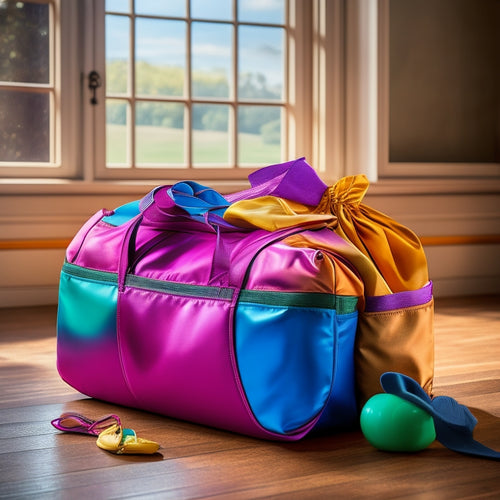
Can You Carry a Suit Bag on a Plane?
Share
You can carry a suit bag on a plane, but it's crucial to research your airline's specific size restrictions and guidelines to guarantee a stress-free travel experience. Measure your bag accurately, including protruding parts, to confirm it fits in the overhead bin or meets size requirements. Familiarize yourself with TSA and FAA regulations to prevent last-minute hassles. From packing tips to airline policies, there's a lot to take into account. Want to avoid wrinkles, extra fees, and security delays?
Key Takeaways
• Check airline's size restrictions and specific guidelines for garment bags to avoid stress and last-minute hassles.
• Measure your suit bag accurately, including protruding parts, to ensure it fits in overhead bins or meets size requirements.
• Familiarize yourself with TSA and FAA regulations to avoid delays or issues during airport security checks.
• Choose a durable, water-resistant, and compact suit bag that meets airline and TSA regulations for smooth travel.
• Pack strategically, leaving extra space for souvenirs, and consider folding or gate-checking if your bag doesn't meet airline size requirements.
Suit Bag Size and Airline Rules
When preparing to carry a suit bag on a plane, you'll need to check the airline's size restrictions, as they vary from one carrier to another, and some may have specific guidelines for garment bags. You don't want to show up at the gate only to find out your bag is too big.
Baggage handlers are notorious for being rough, and you don't want your suit to arrive wrinkled or damaged. If the airline is liable for damage, you'll need to prove it was their fault. Researching the airline's rules beforehand will save you stress and potential airline liabilities. Make sure to check the website or call customer service to confirm their policies.
Measuring Your Suit Bag Correctly
When measuring your suit bag, you'll want to get it just right to guarantee it fits in the overhead bin or meets the airline's size requirements.
You'll need to measure the bag's length, width, and height, making sure to include any protruding parts like wheels or handles.
Bag Size Matters
As you prepare to carry your suit bag on a plane, measuring it accurately is crucial to guarantee a stress-free travel experience. You don't want to deal with suitcase anxiety or baggage woes, so get out your measuring tape!
To make sure your bag fits in the overhead compartment or under the seat, check its dimensions against these guidelines:
- Length: Measure from the bottom of the bag to the top, including handles and wheels.
- Width: Measure the bag's widest point, including any protruding parts.
- Height: Measure the bag's tallest point, including handles and wheels.
- Depth: Measure the bag's thickness, from front to back.
Measure Carefully Twice
You'll want to measure your suit bag carefully, taking your time to guarantee accuracy, since even a slight miscalculation can make a big difference in whether your bag fits in the overhead compartment or under the seat.
To avoid travel anxiety, get into a packing mindset and take precise measurements of your bag's length, width, and height. Don't assume you can eyeball it – grab a tape measure and record the exact dimensions.
Check Airline Specs
Before stowing your suit bag in the overhead compartment, verify the airline's specifications to confirm it meets their size requirements, saving you from potential gate-checking or last-minute luggage rearrangements.
Airline variations can be significant, and what fits on one carrier may not fit on another. During peak travel seasons, overhead space can be important to check specs. Here are some key measurements to check:
-
Linear inches: Add length, width, and height to make sure your bag doesn't exceed the airline's maximum linear inches.
-
Width and height: Check the maximum width and height allowed in the overhead compartment.
-
Depth: Make sure your bag fits snugly in the compartment without protruding.
- Weight: Some airlines have weight restrictions, so be sure to check those too.
TSA and FAA Regulations Explained
When packing your suit bag for a flight, make sure to familiarize yourself with the Transportation Security Administration (TSA) and Federal Aviation Administration (FAA) regulations to avoid any last-minute hassles or delays.
You'll want to check the TSA's Guidance on traveling with special items, as suit bags can fall under this category. Additionally, confirm your airline is compliant with FAA regulations, as they may have specific guidelines for carrying suit bags on board.
Types of Suit Bags and Restrictions
Different types of suit bags come with varying restrictions, and understanding which type you have can make all the difference in complying with airline and TSA regulations. You need to know what you're working with to avoid any last-minute hassles at the airport.
Here are some common types of suit bags and their restrictions:
-
Leather Options: Classic and stylish, but may have size or weight restrictions due to their luxurious materials.
-
Luxury Materials: High-end bags with premium fabrics, which might require additional screening or handling.
-
Soft-Sided Bags: Flexible and lightweight, but may not provide the same protection as harder cases.
- Hard-Sided Cases: Sturdy and protective, but might be heavier or larger, affecting carry-on or checked bag status.
Understanding your suit bag's type and restrictions will help you navigate airport security and airline rules with confidence.
Packing Tips for Your Suit Bag
By strategically packing your suit bag, you can guarantee your clothes arrive at their destination in pristine condition. To guarantee a wrinkle-free arrival, start by laying out your outfit and accessories on a flat surface. Roll your clothes to save space and reduce creases.
Pack essential travel accessories like a garment bag, packing cubes, and a travel-sized steamer to keep your attire fresh. Consider investing in packing essentials like cloth bags or packing paper to protect delicate fabrics.
Don't forget to leave some extra space in your bag for souvenirs or unexpected items. With these packing tips, you'll be confident that your suit will arrive looking sharp and ready for your destination.
Carry-On or Check-In: What's Better
You've carefully packed your suit bag, but now it's time to decide how to get it onto the plane: will you carry it on or check it in? This decision largely depends on your personal preference and travel style. Here are some factors to take into account:
-
Security: If you're worried about your suit getting damaged or lost, carrying it on might be the better option.
-
Convenience: If you have a tight connection, checking your bag might save you time and stress.
-
Size restrictions: If your suit bag is small enough, carrying it on might be the way to go.
- Risk tolerance: If you're okay with the risk of your bag getting lost or delayed, checking it in might be the better choice.
Ultimately, the decision to carry on or check in your suit bag comes down to what you're comfortable with and what works best for your travel plans.
Wrinkle-Free Travel Hacks for Suits
When you're traveling with a suit, you want to arrive looking sharp, not wrinkled. To guarantee you step off the plane looking polished, mastering some simple yet effective packing strategies is crucial.
Packing Strategies Matter
To ensure your suit arrives at your destination looking crisp and professional, mastering the art of packing it correctly in your carry-on luggage is vital. As a savvy traveler, you know that packing psychology plays a significant role in maintaining your suit's integrity. Your travel philosophy should prioritize efficiency and practicality.
Here are some essential packing strategies to keep in mind:
-
Choose the right luggage: Opt for a carry-on with a dedicated suit compartment or a garment bag.
-
Use packing cubes: These help keep your suit organized and prevent wrinkles.
-
Pack clothes in layers: This allows for easy removal and re-packing if needed.
- Consider a travel-sized steamer: A quick steam can work wonders for revitalizing your suit.
Fold or Roll Options
By folding or rolling your suit strategically, you can minimize wrinkles and guarantee a smooth, hassle-free arrival at your destination. When it comes to fold techniques, try the 'bundle fold' or 'konMari fold' to keep your suit compact and wrinkle-free.
For roll strategies, use a cylindrical shape to maintain the suit's natural fibers and prevent creases. You can also use a garment bag or cloth to separate your suit from other items in your luggage. Remember, the key is to minimize folding and bending, as these can cause wrinkles and damage to your suit.
With the right fold or roll, you'll be confident and stylish upon arrival.
Bag Selection Essentials
You'll need a suitable bag to protect your carefully folded or rolled suit during travel, and that's where bag selection comes in. A good bag will keep your suit wrinkle-free and organized, making your travel experience much smoother.
Here are some essentials to take into account when choosing a bag:
-
Material options: Look for durable, water-resistant materials like nylon or polyester.
-
Color choices: Opt for neutral colors like black, navy, or gray that won't show dirt or stains.
-
Size and compartments: Choose a bag with multiple compartments to keep your belongings organized.
- Weight and portability: Select a lightweight bag with comfortable handles or straps for easy carrying.
Airline Suit Bag Policies Compared
Comparing airline suit bag policies can be a challenging task, especially when each carrier seems to have its own set of rules and restrictions. As you prepare for your trip, understanding these differences is essential.
For instance, some airlines like Delta and American Airlines allow suit bags as personal items, while others like Spirit and Frontier charge extra fees. Your traveler experiences can greatly vary depending on the airline you choose.
When researching, look for specific guidelines on size, weight, and type of bag allowed. Be prepared to fold or gate-check your suit bag if it doesn't meet the requirements.
Frequently Asked Questions
Can I Use a Garment Bag as a Personal Item?
You can totally use a garment bag as a personal item, packing your formal attire and other travel essentials, as long as it fits under the seat in front of you or in the overhead bin.
Do Suit Bags Count Towards My Carry-On Allowance?
As you soar through the skies, you wonder: do suit bags count towards your carry-on allowance? Check your airline's travel policies, as carry-on restrictions and bag fees vary, ensuring you're not weighed down by luggage limits.
Can I Pack Shoes in My Suit Bag?
When packing shoes in your suit bag, use Shoe Protectors to prevent scuffs, and employ clever packing strategies like rolling clothes to maximize space, so you can fit everything you need for your trip.
Will a Suit Bag Fit in the Plane's Overhead Compartment?
You'll want to check with your airline for their bin space dimensions, as they vary, and measure your suit bag to make sure it fits; some airlines have more generous overhead compartments than others, so it's worth checking ahead of time.
Can I Gate-Check My Suit Bag if It's Too Large?
If your suit bag is too large, you can gate-check it, but make sure to check your airline's policies and take steps for bag protection, like wrapping it in plastic or using a protective cover.
Related Posts
-

Dancewear Bags to Keep You Organized and Stylish
When it comes to dancewear bags, you want something that's both functional and stylish. Look for durable materials li...
-

Wireless Bluetooth Speakers With the Longest Battery Life
If you're in the market for wireless Bluetooth speakers with the longest battery life, look for models boasting over ...
-

Dance Poster Showcases Array of Dance Styles
In addition to showcasing a diverse array of dance styles, dance posters provide a visually engaging tool for cultura...


